-

新人教版高中英语选修2Unit 4 Reading for writing教学设计
假定你是英国的Jack,打算来中国旅行,请你给你的中国笔友李华写一封信,要点如下:1.你的旅行计划:北京→泰山→杭州;2.征求建议并询问他是否愿意充当你的导游。注意:1.词数80左右(开头和结尾已给出,不计入总词数);2.可以适当增加细节,以使行文连贯。参考词汇:故宫 the Forbidden City;泰山 Mount TaiDear Li Hua,I'm glad to tell you that 'm going to visit China.First,I am planning to visit Beijing,the capitalof China,where I am looking forward to enjoying the Great Wall,the Forbidden City and somebeautiful parks.Then I intend to go to visit Mount Tai in Shandong Province.I've heard that it is one ofthe most famous mountains in China and I can't wait to enjoy the amazing sunrise there.After that,I amalso going to Hangzhou.It is said that it is a beautiful modern city with breathtaking natural sights,among which the West Lake is a well- known tourist attraction.What do you think of my travel plan? Will you act as my guide? Hope to hear from you soon.

新人教版高中英语选修2Unit 4 Using langauge-Listening教学设计
The theme of the listening section is " talking about scenery and culture along a journey."The part is designed to further lead the students to understand Canadian natural geography and social environment, and integrated into the cultural contrast by mentioning the long train journey from Beijing to Moscow routes. On this basis, the part activates students related travel experience, lets the student serial dialogue, guides the student to explore further the pleasure and meaning of the long journey, and Chinese and foreign cultural comparison.The part also provides a framework for the continuation of the dialogue, which is designed to provide a framework for students to successfully complete their oral expressions, and to incorporate an important trading strategy to end the dialogue naturally.1. Help students to understand and master some common English idioms in the context, and experience the expression effect of English idioms.2. Guide the students to understand the identity of different people in the listening context, and finish the dialogue according to their own experience.3. Instruct the students to use appropriate language to express surprise and curiosity about space and place in the dialogue, and master the oral strategy of ending the dialogue naturally.1. Instruct students to grasp the key information and important details of the dialogue.2. Instruct students to conduct a similar talk on the relevant topic.

新人教版高中英语选修2Unit 5 Learning about Language教学设计
The purpose of this section of vocabulary exercises is to consolidate the key words in the first part of the reading text, let the students write the words according to the English definition, and focus on the detection of the meaning and spelling of the new words. The teaching design includes use English definition to explain words, which is conducive to improving students' interest in vocabulary learning, cultivating their sense of English language and thinking in English, and making students willing to use this method to better grasp the meaning of words, expand their vocabulary, and improve their ability of vocabulary application. Besides, the design offers more context including sentences and short passage for students to practice words flexibly.1. Guide students to understand and consolidate the meaning and usage of the vocabulary in the context, 2. Guide the students to use the unit topic vocabulary in a richer context3. Let the students sort out and accumulate the accumulated vocabulary, establishes the semantic connection between the vocabulary,4. Enable students to understand and master the vocabulary more effectivelyGuiding the Ss to use unit topic words and the sentence patterns in a richer context.Step1: Read the passage about chemical burns and fill in the blanks with the correct forms of the words in the box.

新人教版高中英语选修2Unit 5 Reading and thinking教学设计
The theme of this activity is to learn the first aid knowledge of burns. Burns is common in life, but there are some misunderstandings in manual treatment. This activity provides students with correct first aid methods, so as not to take them for granted in an emergency. This section guides students to analyze the causes of scald and help students avoid such things. From the perspective of text structure and collaborative features, the text is expository. Expository, with explanation as the main way of expression, transmits knowledge and information to readers by analyzing concepts and elaborating examples. This text arranges the information in logical order, clearly presents three parts of the content through the subtitle, accurately describes the causes, types, characteristics and first aid measures of burns, and some paragraphs use topic sentences to summarize the main idea, and the level is very clear.1. Guide students to understand the causes, types, characteristics and first aid methods of burns, through reading2. Enhance students’ ability to deal withburnss and their awareness of burns prevention3. Enable students to improve the ability to judge the types of texts accurately and to master the characteristics and writing techniques of expository texts.Guide students to understand the causes, types, characteristics and first aid methods of burns, through readingStep1: Lead in by discussing the related topic:1. What first-aid techniques do you know of ?CPR; mouth to mouth artificial respiration; the Heimlich Manoeuvre

新人教版高中英语选修2Unit 5 Using langauge-Listening教学设计
The theme of this section is to learn how to make emergency calls. Students should learn how to make emergency calls not only in China, but also in foreign countries in English, so that they can be prepared for future situations outside the home.The emergency telephone number is a vital hotline, which should be the most clear, rapid and effective communication with the acute operator.This section helps students to understand the emergency calls in some countries and the precautions for making emergency calls. Through the study of this section, students can accumulate common expressions and sentence patterns in this context. 1.Help students accumulate emergency telephone numbers in different countries and learn more about first aid2.Guide the students to understand the contents and instructions of the telephone, grasp the characteristics of the emergency telephone and the requirements of the emergency telephone.3.Guide students to understand the first aid instructions of the operators.4.Enable Ss to make simulated emergency calls with their partners in the language they have learned1. Instruct students to grasp the key information and important details of the dialogue.2. Instruct students to conduct a similar talk on the relevant topic.Step1:Look and discuss:Match the pictures below to the medical emergencies, and then discuss the questions in groups.
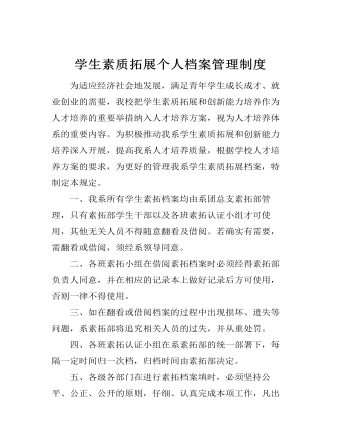
学生素质拓展个人档案管理制度
一、我系所有学生素拓档案均由系团总支素拓部管理,只有素拓部学生干部以及各班素拓认证小组才可使用,其他无关人员不得随意翻看及借阅。若确实有需要,需翻看或借阅,须经系领导同意。 二、各班素拓小组在借阅素拓档案时必须经得素拓部负责人同意,并在相应的记录本上做好记录后方可使用,否则一律不得使用。
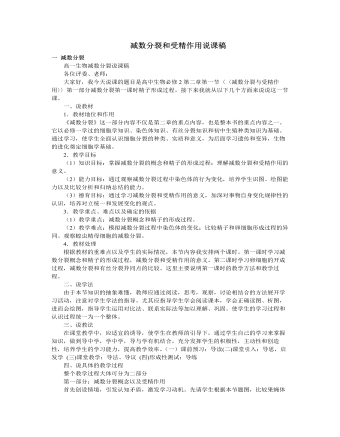
人教版高中生物必修2减数分裂和受精作用说课稿
一 减数分裂高一生物减数分裂说课稿各位评委、老师:大家好,我今天说课的题目是高中生物必修2第二章第一节〈〈减数分裂与受精作用〉〉第一部分减数分裂第一课时精子形成过程。接下来我就从以下几个方面来说说这一节课。一、说教材1.教材地位和作用《减数分裂》这一部分内容不仅是第二章的重点内容,也是整本书的重点内容之一。它以必修一学过的细胞学知识、染色体知识、有丝分裂知识和初中生殖种类知识为基础。通过学习,使学生全面认识细胞分裂的种类、实质和意义,为后面学习遗传和变异,生物的进化奠定细胞学基础。2.教学目标(1)知识目标:掌握减数分裂的概念和精子的形成过程;理解减数分裂和受精作用的意义。(2)能力目标:通过观察减数分裂过程中染色体的行为变化,培养学生识图、绘图能力以及比较分析和归纳总结的能力。
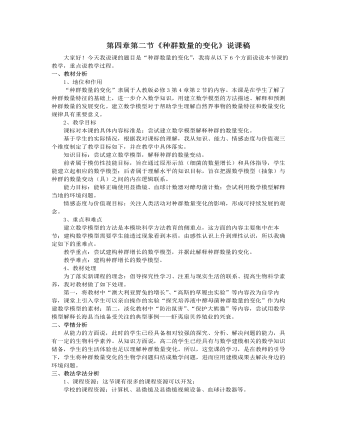
人教版高中生物必修3第四章第二节《种群数量的变化》说课稿
4、种群数量变化的其他类型我结合“种群数量下降”这个知识点对学生进行寓教。现今的自然界,许多野生生物种群的数量都在下降,为什么呢?我提供了世界人口近2000年的种群增长曲线,一切都在不言而喻中。现今社会的主题是呼吁建立和谐社会,作为生物老师,我想它不应该仅仅指人与人之间的和谐,也不应该仅仅指人与社会之间的和谐,它更应该昭示着人与自然之间的和谐,人类只有学会与自然和谐相处,才能在生物圈中享受最大的幸福。6、小结课程在实验的大背景下展开,也在实验的背景中结束,这里可以呈现出一个完整的探究思路。同时,学生思考如何实现多种预期过程,相当于对本课进行小结。五、效果预测课堂上选取的内容基于学生的生活体验,创设的情境能激发学生的兴趣,设置的问题符合学生的认知水平,有助于学生能力的提高,教学目标可以基本实现。
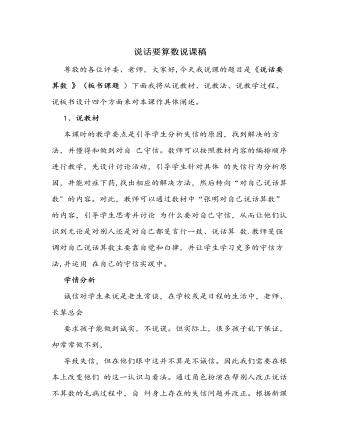
人教部编版道德与法制四年级下册说话要算数说课稿
a.失信的害处有哪些?b.失信于人会对别人造成什么伤害?c.失信于人会对自己造成什么伤害?总结:从古至今,失信于人害人害己,我们可千万不能做害人害己的傻事。四、面对说话算数的人,我们的态度1.情景剧表演:张青和李媛是好朋友……虽然李媛没能和张青一起看话剧,但是张青觉得,李媛是一个说话算数的人。a.你认为李媛是个说话算数的人吗?为什么?b.你的生活中有说话算数的人吗?讲一讲他们的故事吧。2.夸夸这些守信的人a.出示守信的成语故事,请小朋友夸夸他们。总结:上了这堂课,你觉得守信重要吗?说话不算数只会给我们带来害处,而守信却能带给我们尊重,如何选择一目了然。
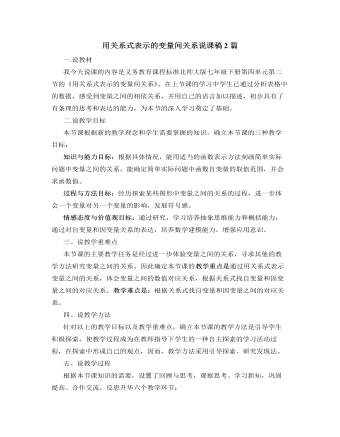
北师大版初中七年级数学下册用关系式表示的变量间关系说课稿2篇
一.说教材我今天说课的内容是义务教育课程标准北师大版七年级下册第四单元第二节的《用关系式表示的变量间关系》。在上节课的学习中学生已通过分析表格中的数据,感受到变量之间的相依关系,并用自己的语言加以描述,初步具有了有条理的思考和表达的能力,为本节的深入学习奠定了基础。二.说教学目标本节课根据新的教学理念和学生需要掌握的知识,确立本节课的三种教学目标:知识与能力目标:根据具体情况,能用适当的函数表示方法刻画简单实际问题中变量之间的关系,能确定简单实际问题中函数自变量的取值范围,并会求函数值。过程与方法目标:经历探索某些图形中变量之间的关系的过程,进一步体会一个变量对另一个变量的影响,发展符号感。情感态度与价值观目标:通过研究,学习培养抽象思维能力和概括能力,通过对自变量和因变量关系的表达,培养数学建模能力,增强应用意识。
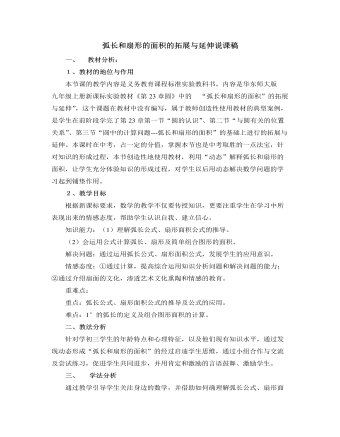
北师大版初中数学九年级下册弧长和扇形的面积的拓展与延伸说课稿
五、教学反思:时钟的秒针、分针、时针扫的图形, 汽车挡风玻璃的刮水器;刷工人刷过的面积近似看为扇形。圆中的计算问题---弧长和扇形的面积,虽然新课标、新教材要求学习,但本节教师结合学生的实际要求,将其作为内容进行拓展与延伸,具有一定的实际意义。用生活中动态几何解释扇形,体验解决问题策略的多样性,发展实践能力与创新精神。本节课,教师通过“扇子”的问题情景引入新课,它蕴含了大量的情感信息,有效激发学生的求知欲望,充分调动学生的学习积极性,注重学生的参与,让出时间与空间由学生动手实践,鼓励学生自主探索、合作交流、展示成果,提高了学生发现问题、提出问题、解决问题的能力。用“扇子变化”,帮助学生探索自然界中事物的动静结合问题,利用“扇子的文化”的新奇感激起学生的学习热情,陶冶了学生的学习情操,从而使学生更深切地理解问题,使原本单调枯燥的数学变得生动、形象,激发学生的情感,使课堂充满生机。
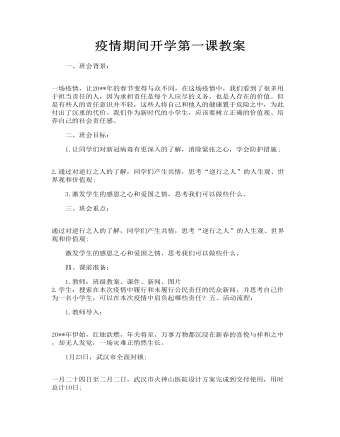
疫情期间开学第一课教案 开学第一课新冠病毒教案
三、班会重点: 通过对逆行之人的了解,同学们产生共情,思考“逆行之人”的人生观、世界观和价值观; 激发学生的感恩之心和爱国之情,思考我们可以做些什么。 四、课前准备: 1.教师:班级教案、课件、新闻、图片 2.学生:搜索在本次疫情中履行和未履行公民责任的民众新闻,并思考自己作为一名小学生,可以在本次疫情中肩负起哪些责任? 五、活动流程:
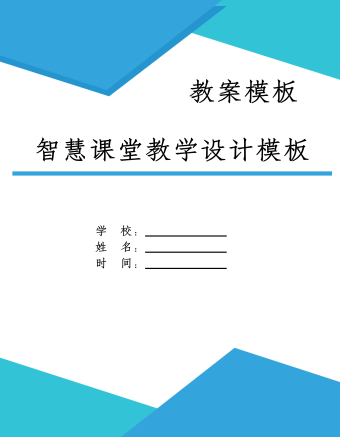
分式方程的解法及应用教学设计与学案
内容:分式方程的解法及应用——初三中考数学第一轮复习学习目标:1、熟练利用去分母化分式方程为整式方程2、熟练利用分式方程的解法解决含参数的分式方程的问题重点:分式方程的解法(尤其要理解“验”的重要性)难点:含参数的分式方程问题预习内容:1、观看《分式方程的解法》《含参数分式方程增根问题》《解含参分式方程》视频2、完成预习检测
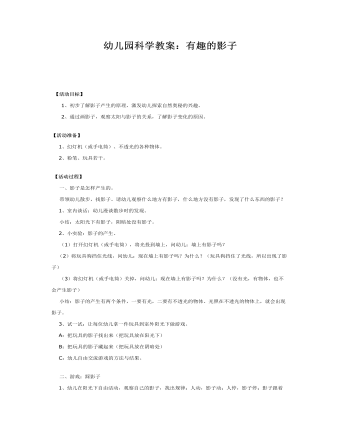
幼儿园科学教案:有趣的影子
2、通过画影子,观察太阳与影子的关系,了解影子变化的原因。【活动准备】 1、幻灯机(或手电筒)、不透光的各种物体。 2、粉笔、玩具若干。 【活动过程】 一、影子是怎样产生的。 带领幼儿散步,找影子。请幼儿观察什么地方有影子,什么地方没有影子,发现了什么东西的影子? 1、室内谈话:幼儿漫谈散步时的发现。 小结:太阳光下有影子,阴暗处没有影子。 2、小实验:影子的产生。 (1)打开幻灯机(或手电筒),将光投到墙上,问幼儿:墙上有影子吗? (2)将玩具狗挡住光线,问幼儿:现在墙上有影子吗?为什么?(玩具狗挡住了光线,所以出现了影子) (3)将幻灯机(或手电筒)关掉,问幼儿:现在墙上有影子吗?为什么?(没有光,有物体,也不会产生影子)
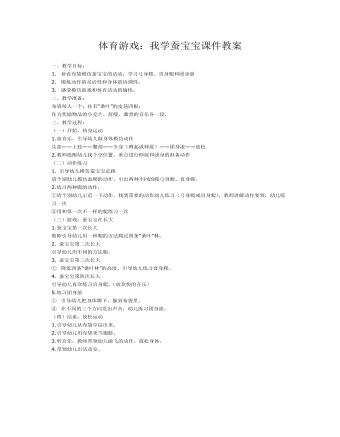
体育游戏:我学蚕宝宝课件教案
2. 锻炼动作的灵活性和身体的协调性。 3. 感受模仿游戏和体育活动的愉快。 二、教学准备: 布袋每人一个;挂有“桑叶”的皮筋四根; 作为奖励物品的小亮片,舒缓、激烈的音乐各一段, 三、教学过程: (一)开始,热身运动 1.放音乐,引导幼儿做身体模仿动作 头部——上肢——腰部——全身(蹲起或伸展)——团身滚——放松 2.教师提醒幼儿找个空位置,重点进行伸展和团身的准备动作

开展《吸烟有害健康》主题班会教案八篇
(一)为何禁止青少年吸烟:根据世界卫生组织的统计,在世界各地每8秒钟就有一人死于与吸烟有关的疾病,每年有近500 万人因吸烟致死。这一数字在未来20 年中将有可能增加一倍。吸烟已经成为世界上最主要的致死因素之一。我国是一个烟草大国,目前吸烟人数约为3.2亿。在控制未成年人吸烟这个问题上,政府做了大量的工作,并于去年11月10日签署了联合国《烟草控制框架公约》,这一公约将于今年2月28日正式生效。但一个不容回避的事实是:在我国,未成年人吸烟率呈上升趋势,未成年人开始吸烟的年龄在下降,每天有8 万左右青少年成为长期烟民。这种状况不但影响了孩子的健康成长,而且严重影响我国整体国民身体素质的提高,所以未成年人吸烟问题越来越引起社会的广泛关注。
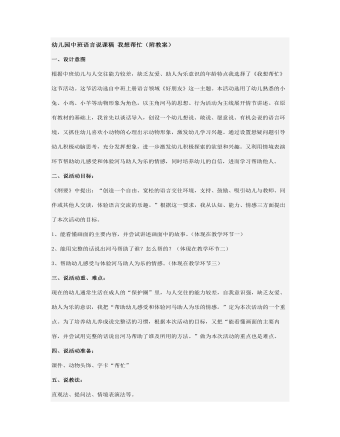
幼儿园中班语言说课稿:我想帮忙(附教案)
本次活动我设计以下三个环节:一、展示《我想帮忙》课件,引导幼儿看图说话,并认读词语:帮忙。二、引导幼儿情境讲述,进一步理解画面内容。三、尝试表演,感受和体验河马助人为乐的情感。一、展示《我想帮忙》课件,引导幼儿看图说话,并认读词语:帮忙。1、谈话导入:(教师神秘地说)告诉大家一个秘密:老师发现了一群小动物们之间的故事,你们想知道吗?可是,小动物们说了要想知道它们的秘密必须靠小朋友自己,要用自己的小眼睛认真观察,动脑筋思考,还要大胆回答出问题才行呢!大家能做到吗?就让我们一起来试试吧!(出示幻灯一)引导幼儿说说画面中的小动物们都在干什么。(出示幻灯二)猜猜“河马会怎么帮忙呢?”(这样的设计就是抓住幼儿喜欢小动物的心理,利用幼儿观察小动物们生活化的动作形态和解答悬疑问题,激发幼儿的学习兴趣。)2、(出示幻灯三——六)在展示画面的过程中,引导幼儿认真观察,鼓励幼儿大胆、清楚地表达自己的想法和感受,发展幼儿的语言表达能力和思维能力,并使幼儿养成注意倾听的好习惯。3、认读词语:帮忙。利用字卡和情境画面帮助幼儿直观形象地去了解、认识词语,再通过游戏《帮字宝宝找朋友》进一步加深理解词语。
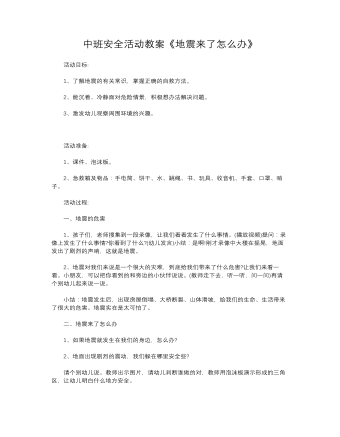
中班安全活动教案《地震来了怎么办》
一、地震的危害 1、孩子们,老师搜集到一段录像,让我们看看发生了什么事情。(播放视频)提问:录像上发生了什么事情?你看到了什么?(幼儿发言)小结:是啊!刚才录像中大楼在摇晃,地面发出了剧烈的声响,这就是地震。 2、地震对我们来说是一个很大的灾难,到底给我们带来了什么危害?让我们来看一看。小朋友,可以把你看到的和旁边的小伙伴说说。(教师走下去,听一听,问一问)再请个别幼儿起来说一说。
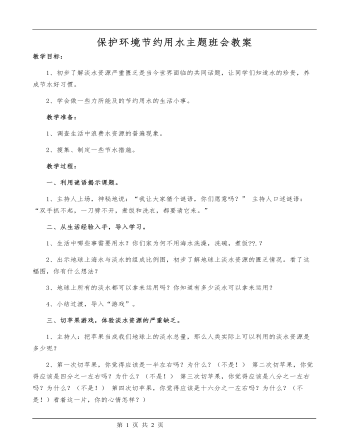
保护环境节约用水主题班会教案
教学准备: 1、调查生活中浪费水资源的普遍现象。 2、搜集、制定一些节水措施。 教学过程: 一、利用谜语揭示课题。 1、主持人上场,神秘地说:“我让大家猜个谜语,你们愿意吗?” 主持人口述谜语: “双手抓不起,一刀劈不开,煮饭和洗衣,都要请它来。” 二、从生活经验入手,导入学习。 1、生活中哪些事需要用水?你们家为何不用海水洗澡,洗碗,煮饭??.? 2、出示地球上海水与淡水的组成比例图,初步了解地球上淡水资源的匮乏情况。看了这幅图,你有什么想法? 3、地球上所有的淡水都可以拿来运用吗?你知道有多少淡水可以拿来运用? 4、小结过渡,导入“游戏”。
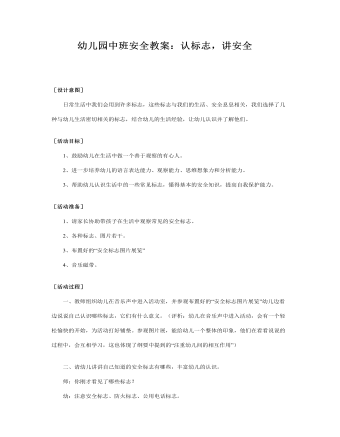
幼儿园中班安全教案:认标志,讲安全
[活动目标]1、鼓励幼儿在生活中做一个善于观察的有心人。2、进一步培养幼儿的语言表达能力、观察能力、思维想象力和分析能力。3、帮助幼儿认识生活中的一些常见标志,懂得基本的安全知识,提高自我保护能力。[活动准备]1、请家长协助带孩子在生活中观察常见的安全标志。2、各种标志、图片若干。3、布置好的“安全标志图片展览”4、音乐磁带。[活动过程] 一、教师组织幼儿在音乐声中进入活动室,并参观布置好的“安全标志图片展览”幼儿边看边说说自己认识哪些标志,它们有什么意义。(评析:幼儿在音乐声中进入活动,会有一个轻松愉快的开始,为活动打好铺垫。参观图片展,能给幼儿一个整体的印象,他们在看看说说的过程中,会互相学习,这也体现了纲要中提到的“注重幼儿间的相互作用”)

